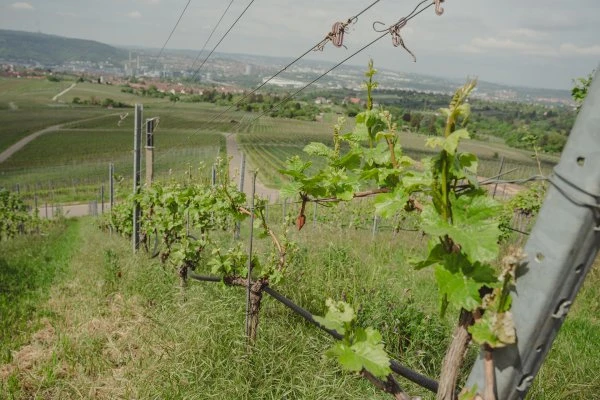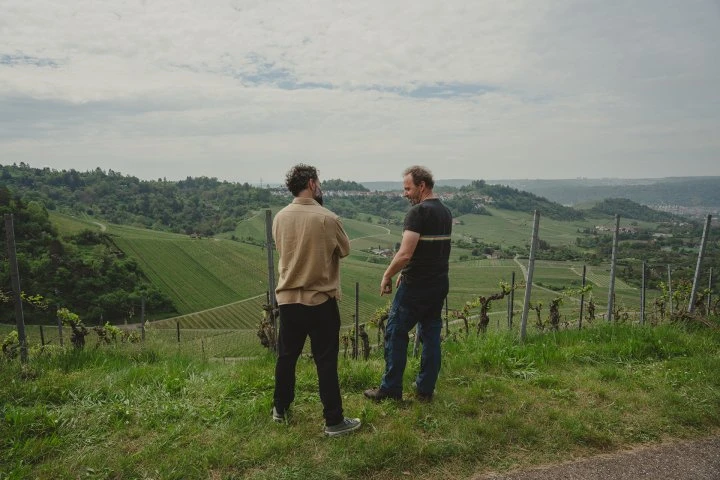
Weingut Schnaitmann
This region boasts a unique terroir, with a mix of factors highly conducive to the production of exceptional wines.
Rainer Schnaitmann, owner of the Weingut Schnaitmann winery, represents the nineteenth generation to cultivate his family's vineyards. And you can taste it, in each and every sip of his labels.
There is no getting around it: I really am Explorer at heart.
I love venturing beyond the most renowned and acclaimed wine destinations. Discovering unexpected wineries and labels that deserve a place of honour alongside the bottles that everyone knows.
Hence, this time, I land in Stuttgart. In just thirty minutes, travelling north, I reach one of Germany's largest wine-growing areas, nestled in the heart of Baden-Württemberg, in south-western Germany.


This area doesn’t receive the same attention as its distinguished neighbours in Burgundy, where the Pinot Noir vineyards are a seductive lure for most any lover of the French nectar. However, what I am to find here not only will leave me speechless, but also help me understand why Stuttgart is such a must-visit destination for wine lovers. The real ones. The ones who know how to appreciate incredible wines like LÄMMLER Lemberger GG.
LÄMMLER Lemberger GG is the incredible red wine from Weingut Schnaitmann. Try it now along with all the winery's other labels.
When I arrive at no. 4 Untertürkheimer Str. in the municipality of Fellbach, I don’t immediately realise I have stepped into a page of history. Rainer Schnaitmann, the owner of the Weingut Schnaitmann winery, welcomes me at the entrance with disarming affability and a warmth which, perhaps due to my own preconceptions, I don’t always associate with German people.
It takes but a few moments for him to disappear inside and return clutching a handful of bottles: Well, what are we waiting for? Let's go straight to the vineyard!
Rainer's family has been involved in winegrowing for seven hundred years, even though, for much of the 20th century, they were winegrowers and not producers. The wine estate proper was founded in 1997 when Rainer, who had studied architecture, returned to his family's roots with a genuine ambition and a strong desire to realise the potential of his estate.
Become an Explorer
Every month we will present an unknown and exclusive winery we have discovered. Every month you will receive what we consider to be its best bottle delivered directly to your door: a wine that is always new, exclusive and surprising. At Christmas, 10% discount.
In the early 1990s, convinced that the regional vineyards had immense untapped potential, Rainer studied oenology and travelled abroad to learn how to produce great wines. Today, as I sit beside him in the car on the way to the vineyards, I literally hang on his every word.
This man with a centuries-old heritage describes a land of which I know next to nothing.

This region boasts a unique terroir, with a mix of factors highly conducive to the production of exceptional wines. The microclimate, soils and topography of an area nestled between the Black Forest and the Jura are expressed in complex, balanced and iconic wines. There, - he tells me - now I have finished the part I had prepared - and bursts into a hearty laugh.
Joyful, empathetic and also known as the “Prince of Württemberg”, Rainer is considered one of the most highly respected Pinot Noir producers in all Germany. And I want to understand why.
Visiting all 160 plots of his estate, spread over 26 hectares, is out of the question. However, Rainer knows exactly what is most likely to excite his guests, choosing it with care and displaying it with all the skill of a consummate thespian.
The view is breathtaking. Stuttgart is just a few minutes' drive away, practically below us, and the iconic Porsche and Mercedes factories are emblematic of the contrast between the city and nature. All around us, nestled in a 600 square metre vineyard, Rainer's smallest, surreally sloping terraces alternate with endless rows of vines, outlining a landscape comparable to the Valtellina.
My vineyards are spread across a number of different sites in Württemberg: Lammler, Goldberg, Mönchberg, Schlossberg, Götzenberg and Altenberg. Each is characterised by its own soil type and microclimate and it is this diversity that enables us to cultivate a wide range of varieties, including Riesling, Pinot Noir and the region's favourite: Lemberger.
Rainer pours a glass of what he calls “a game”: a very easy-drinking Rosé, perfect for quenching our thirst in the unexpectedly warm German weather. You're feeling the heat, aren’t you? - he asks teasingly – Well, that’s Germany for you! And we burst out laughing.

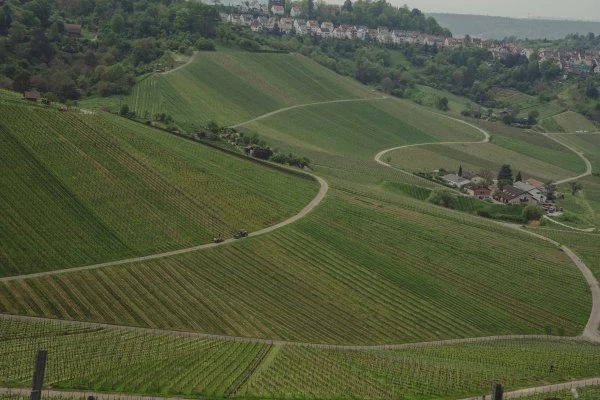
The tall grass comes up to our knees. As we walk, the scents and aromas of pristine, unspoilt countryside rise up and envelope us, reminding us how limited the extent of human intervention is here: the Weingut Schnaitmann winery has been operating entirely organically since 2008 and, since 2022, has been biodynamically certified as a member of Respekt Biodyn. During our walk, Rainer explains to me that many of the wineries and vineyards in the region have been handed down from generation to generation, which is why the plots can be quite small.
Looking about me as I listen to him, the first thing I realise was that I knew nothing about the place. This is not the Germany I had been expecting, although I couldn't say quite what that Germany was. I breathe in a seductive quietness, which transports you back to a bucolic life, where it is only natural to greet every person you meet along the way with a cheery ‘Hello!’. I discover a fervent bustle of strangers and fraternal friends, mingling daily between those who stroll to regenerate themselves and those tirelessly working among the rows of vines.
Rainer's love for this place is so compelling that I am at a loss for words to describe it.
He tells me that his goal is simple but profound: to create wines that authentically express this unique terroir, giving priority to the well-being of the vineyards and the surrounding environment.
At a certain point, he pauses to show me the plot of land he seems most proud of. Nestled amongst houses and buildings, I can barely make it out. A tiny plot, right there in the centre of Stuttgart: the only vineyard in the city. When my astonished gaze returns to Rainer, his chest seems to have suddenly, and quite understandably, puffed up with pride.
Rainer represents the 19th generation to cultivate his family's vineyards. His tireless pursuit of excellence and perfection was rewarded in 2006, when he was invited to join the Verband Deutscher Prädikatsweingüter*: the Association of German Prädikat Wine Estates. His wine estate is the youngest ever to be part of the association and the Eagle** on the neck of each bottle represents the very pinnacle of his production.


*The VDP and its approximately 200 members form the qualitative spearhead of German wine growing. The association's clear organisational structure is designed to ensure that it can effectively uphold high quality standards in German wine at all times.
**The eagle symbol on the neck of each bottle indicates membership of the club of the best producers in Germany (VDP).
Exchanging a quick, knowing glance, Rainer and I resolve that it is time to go back to the cellar and enjoy ourselves.
The echo of a melody echoes in the distance, as if it were a whisper carried on the wind. I follow Rainer into the meanders of his cellar as, door after door, the intensity of the music increases and the thick walls hint at the sound. The ancient stone stairs descend steeply and everything around us has an almost ecclesiastical appearance. Dozens of candles scattered in every nook and cranny illuminate the entire cellar, while from the ceiling two huge candelabras catch the eye and Johann Sebastian Bach - I now recognise it - resounds uninterrupted like an endless chant.
I don't know whether the Riesling would prefer AC/DC, - Rainer tells me - or, indeed, whether Pinot Noir would be more into the Rolling Stones, so I just figured that Bach would put everyone on the same page.
His reasoning is absolutely on point and the atmosphere is of an emotional depth that is hard to describe and just invites you to sit back, close your eyes and savour a glass.
Every sip of wine is like breathing in the very vineyard it comes from.
Among all the labels of outstanding quality I had the good fortune to sample, I have selected the six that best represent for me the miracles unfolding and ambitions being shared on this estate.


SIMONROTH Spätburgunder. A Pinot Noir grape variety, it is exceptionally refined and dense on the nose. Early autumn leaves, violets, roasted almonds, juniper, red meat and iodine are followed by clear fruity notes, such as redcurrants and blackcurrants as well as sour cherries. A lively acidity and subtly grained tannins create a dense and powerful structure. This wine draws great freshness and length from its minerality with subtle iron notes. The wood is perfectly integrated. It has incredible potential.
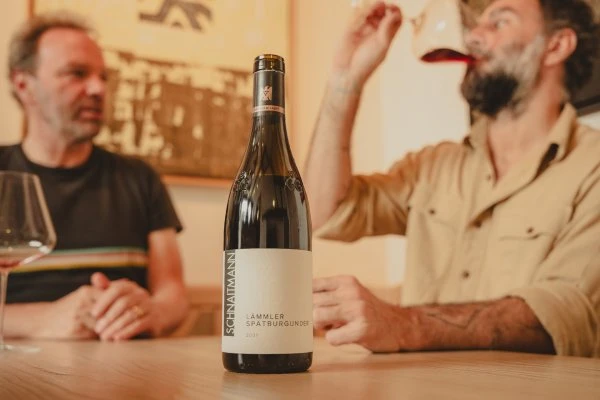
LÄMMLER Spätburgunder GG. A Pinot Noir grape variety from a 0.5 hectare plot of vines over 60 years old. I can see why Rainer has built his entire reputation on Pinot Noir. With a ruby-red heart, it gleams in the glass. Fresh autumn leaves, mint, violets, vanilla, porcini mushrooms, roasted hazelnuts and coffee and undergrowth. Delicate fruity notes of red and black berries and sour cherries. The palate is powerful and concentrated, the acidity elegant and stimulating, the tannic structure silky and dense and it is very persistent with an abundance of freshness. It can live forever!


SIMONROTH Lemberger. This is a Lemberger grape variety. Scents of violets, thyme, juniper wood, laurel and black pepper are accompanied by redcurrants, blackcurrants, sour cherries and plum compote. A lively and beautifully balanced Lemberger, thanks to its ripe acidity, fine fruit, velvety tannic structure and excellently integrated wood. It has an impressive length.
Not yet satisfied with his amazing hospitality, Rainer takes me back to the cellar to taste a white wine, still in the making, drawn straight from the tank.

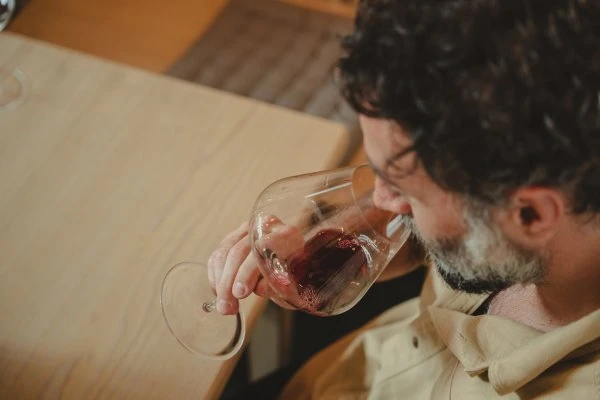
LÄMMLER Lemberger GG. This is a Lemberger grape variety. It ranges from floral spicy notes such as vanilla, pine needles, violet, coffee, thyme, juniper, bay leaf, iodized salt, raw and smoked meat, to fruity accents such as cassis, redcurrant and black cherry, plum and blackberry. The palate is assertive and complex. Untamed and spicy, with wild berry aromas, a succulent, stimulating acidity, velvety, ripe tannins and a dense structure. The taste is full-bodied, with plenty of freshness and great persistence.

Beutelsbacher Altenberg Riesling. This is a Riesling grape variety. Characterised by a mineral freshness, it has a concentrated clear yellow colour with brilliant sparkling accents. The nose arrives with aromas of pepper, woodruff, thyme and juniper. The fruity aroma displays redcurrant, bergamot, blood orange and ripe peach. The palate is lively, with a powerful, tight structure. The acidity is lively, with an iodine-salty minerality.

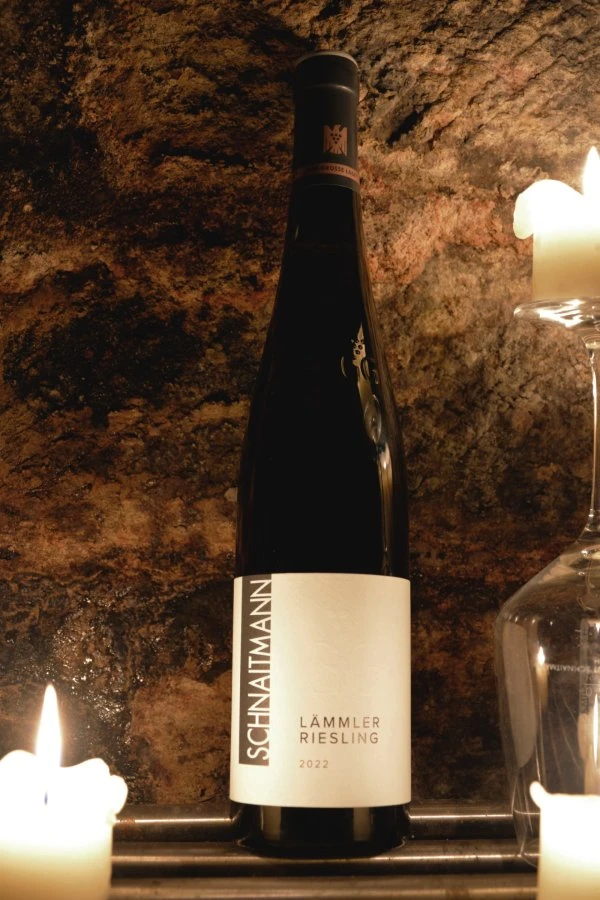
His masterpiece: LÄMMLER Riesling GG. An intense, brilliant golden yellow, it arrives on the nose with elderflower, hazelnut and salted caramel, as well as fine spices such as thyme and cloves, with delicate notes of lemon, apricot, pineapple and peach. A challenging wine with a powerful tautness. Still in the tank and already demonstrating this characteristic, this is a wine that has to be drunk at least once in a lifetime.
We re-emerge into the late afternoon light, with our minds clearer and an entirely different vision of what is happening in and around Stuttgart.

I firmly believe that those who are thirsty to continue learning more about the world of wine should approach German wines with an open mind. Wine production is constantly evolving and pioneers like Rainer are blazing exciting new trails on centuries-old paths. This visit was something truly unique.
From what I’ve seen and tasted, I can say that it is only a matter of time before these wines are recognized for their true worth. I am pleased and satisfied that I can already share them with those who, like me, have a true Explorer's heart.
Then, it is dinner time and I am about to leave. As I approach the car, I hear Rainer calling to me: Maybe we could go to the Cannstatter VolksFest together! It's a real local Oktoberfest. All it takes is my smile and it's a yes. And here I will say no more: because what happens in Stuttgart, stays in Stuttgart.

One year later
A year has passed since we first told the story of Lämmler – Lemberger GG, and today we can say it with certainty: sometimes knowing how to wait truly makes the difference. Giving wine time does not mean slowing down, but allowing it to grow, breathe, and reveal what it had been quietly holding within. After an additional year in the bottle, this Lemberger has reached a remarkable maturity, releasing nuances that back then were only a whisper.
In Rainer’s vision, the Lämmler – Lemberger GG remains a small twist in the tale.
A wine that doesn’t shout, but whispers — always with that velvety voice of someone who knows they have much to say.
Lemberger — also known as Blaufränkisch or, for us Italians, Franconia nera — is one of those grape varieties we approach with a mix of curiosity and suspicion, like an elegant guest arriving from afar, unsure yet whether to trust him.

It is a grape with a surprising personality, a little rebellious and very refined, able to move between elegance and character like a skilled tightrope walker. In the Lämmler cru, time has worked like an invisible tailor: stitching the textures together, softening the edges, adding depth and grace. With further aging, the structure has relaxed, the notes have integrated, and the wine has found a new expressive coherence.
And you realize that for certain kinds of beauty, time is not just important — it is essential.
Subscribe
Every month we will present an unknown and exclusive winery we have discovered. Every month you will receive what we consider to be its best bottle delivered directly to your door: a wine that is always new, exclusive and surprising. At Christmas, 10% discount.




